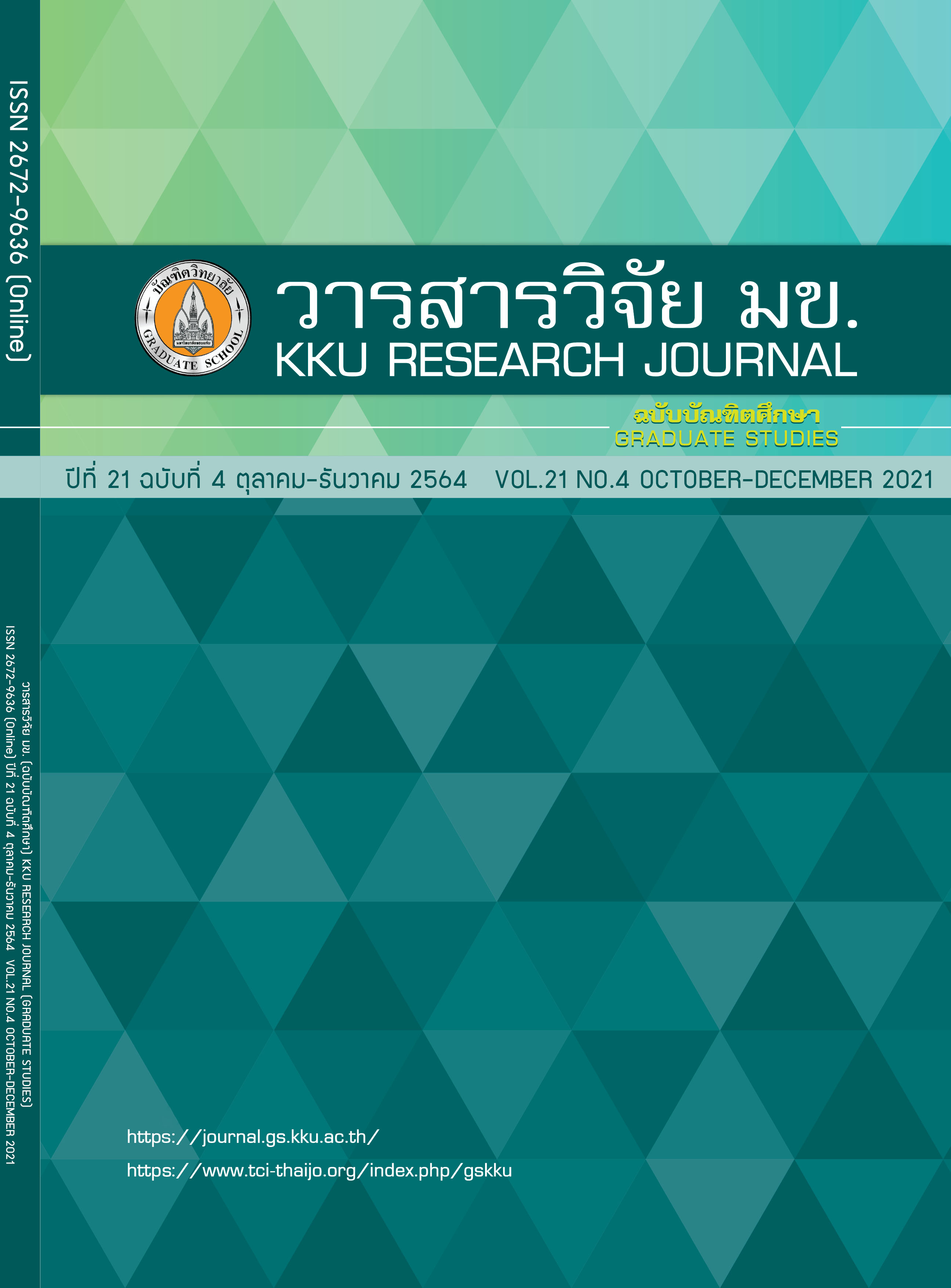An Appropriation Factor of Cassava Single Tuber Peeling Machine for Cassava Chip
Keywords:
Cassava, Peeling, KnifeAbstract
The peeling of cassava roots is an important step in cassava chip processing. Hand or manual peeling is commonly used, but it is slow and lacks sufficient capacity for efficient production. This research aims to design and fabricate a single tuber peeling machine prototype for producing crispy cassava chips. This peeling machine comprises: (1) a structure, (2) power unit, (3) transmission unit, and (4) a set of peeling knives. The experimental conditions were studied at peeling knife speeds of 90, 100, and 110 rpm, using three different degrees of blade and three levels of blade length. The results revealed that the most suitable conditions were a speed of 110 rpm for the peeling knife, using an angle of 20 degrees from the axis and a blade length of 15 mm. These conditions provided 95.09% peeling efficiency, 2.22% texture loss, and a machine capacity of 94.43 kg/h, which was 2.5 times faster than the traditional method (human labour).
References
National Science and Technology Development Agency.(NSTDA). Cassava program Research Framework on Agriculture and Biological Industry [Internet]. 2020 [cited 2020 Jul 20]. Available from: https://www.nstda.or.th/th/th/industrial-research/907-cassava. Thai.
Office of Agricultural Economics. Details of production and marketing situation [Internet]. 2020 [cited 2020 July 20]. Available from: http://www.oae.go.th/view/1/ Weekly Production and Marketing Situation 2020/34277. Thai.
Thai Tapioca Deveiopmant Institute. (TTDI). Benefits of cassava. [Internet]. 2000 [cited 2020 Jul 20]. Available from: https://www.tapiocathai.org/E5.html. Thai.
Daniyan IA, Adeodu AO, Azeez TM, Dada OM, Olafare AO. Optimization of Peeling Time and Operational Speed for Cassava Peeling Using Central Composite Design and Response Surface Methodology. Int J Eng Sci Res Technol. 2012;91(5):1689–1699.
Baba Hassan A. Design and Fabrication of a Cassava Peeling Machine. IOSR J Eng. 2012;02(06):1–8.
Ohwovoriole EN, Oboli S, Mgbeke ACC. Studies and Preliminary Design for a Cassava Tuber Peeling Machine. Trans Am Soc Agric Eng. 1988;31(2):380–385.
Pariyed S, Juckmas L, Aphisit P, Suphan Y, Cherdpong C. Design and Construction of a Cassava Tuber Knife Peeling Unit. J Ind Technol. 2019;15(3):1–11.
Thayawee N, Thavachai T. The Development and Evaluation of a Peeling Machine for Cassava. Agricultural Science Journal. 2549;37:182–185. Thai.
Oluwole OO, Adio MA. Design and Construction of a Batch Cassava Peeling Machine. J M echanical Eng Autom. 2013;3(1):16–21.
Ebunilo P, Egware H, Ukwuaba S. Design and Testing of an Experimental Cassava Tuber Peeling Machine. Int J Eng Res Africa. 2013;9:35–42.
Fadeyibi A, Faith Ajao O. Design and Performance Evaluation of a Multi-Tuber Peeling Machine. AgriEngineering. 2020;2(1):55–71.
Date A. Investigation of cassava tuber physical characteristics and their relationships. 2017;5(September): 207–217.
Malomo O, Bello EK, Adekoyeni OO, Jimoh. Performance Evaluation of an Automated Combined Cassava Grater/Slicer. Int Invent J Biochem Bioinforma [Internet]. 2014;2(3):2408–722. Available from: http://internationalinventjournals.org/journals/IIJBB
Ademosun OC, Jimoh MO, Olukunle OJ. Effect of physical and mechanical properties of cassava tubers on the performance of an automated peeling machine ". Int J Dev Sustain [Internet]. 2012;11(33):810–22. Available from: www.isdsnet.com
Adetan D, Adekoya L, Aluko O. Characterisation of some properties of cassava root tubers. J Food Eng [Internet]. 2003 Oct 1 [cited 2018 Nov 22];59(4):349–53. Available from: https://www.sciencedirect.com/science/article/pii/S0260877402004934
Nathan C, Wadai J, Haruna IU. Comparative analysis of type 3 and type 4 cassava peeling machines. Niger J Technol. 2018;36(4):1088.
Jimoh MO, Olukunle OJ, Manuwa SI. Modeling of cassava peeling performance using dimensional analysis. Agric Eng Int CIGR J. 2016;18(2):360–367.
Olukunle OJ, Ogunlowo AS, Sanni L. The Search for an Effective Cassava Peeler. West Indian J Eng. 2010;32(January):42–47.



